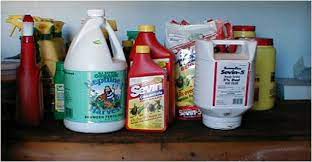Guide to Safe Use of Pesticides
Pesticides are toxic to both pests and humans, but they need not be hazardous to humans and non-target animal species if appropriate precautions are taken.
Most pesticides will cause adverse effects if intentionally or accidentally ingested or if they are in contact with the skin for a long time.
Pesticides particles may be inhaled with the air while they are being sprayed. An additional risk is the contamination of drinking-water, food or soil.
Precautions
Special precautions must be taken during transport, storage and handling of pesticides. Spray equipment should be regularly cleaned and maintained to prevent leaks. People working with pesticides should receive proper training in their safe use.
The Label
Pesticides should be packed and labeled according to World Health Organization (WHO) specifications.
The label should be in English and in the local language, and should indicate the contents, safety instructions (warnings) and possible measures in the event of swallowing or contamination.
Always keep pesticides in their original containers; take safety measures and put on protective clothing as recommended.
Storage and transport
Pesticides should be stored in a place that can be locked and is not accessible to unauthorized people or children; they should never be kept in a place where they might be mistaken for food or drink as some beverages may have the same colour with some pesticides.
Keep them dry but away from fires and out of direct sunlight. Do not carry them in a vehicle that is also used to transport food.
Disposal
Leftover insecticide suspension can be disposed of safely by pouring it into a specially dug hole in the ground or a pit latrine. It should not be disposed of where it may enter water used for drinking or washing, fishponds or rivers.
Read Also : Sanitary Fundamentals and Classification of Pesticide Application
Some insecticides, such as the pyrethroids, are very toxic to fish. Dig a hole at least 100 metres away from the streams, wells and houses. In a hilly area the hole should be on the lower side of such areas. Pour run-off water from hand washings into the hole, and bury containers, boxes and bottles used for pesticides in it.
Close the hole as soon as possible. Cardboard, paper and cleaned plastic containers can be burned, where this is allowed, far away from houses and sources of drinking water. Pyrethroid suspensions can be poured on to dry ground where they are quickly absorbed and degraded and do not cause any environmental problems.
General hygiene
Do not eat, drink or smoke while using insecticide. Keep food in tightly closed boxes. Use suitable equipment for measuring out, mixing and transferring insecticides. Do not stir liquids or scoop pesticides with bare hands.
Use the pressure-release valve of the pump or a soft probe to clear blockages in the nozzle. Wash the hands and face with soap and water each time the pump has been refilled. Eat and drink only after washing the hands and face. Take a shower or bath at the end of the day.
Protective clothing
Pesticides can enter the body in several ways: ingestion, inhalation or contact with the skin. Surveys indicate that most exposure victims contact pesticides through their skin.

Consequently, personal protection equipment must be used when spraying and mixing pesticides, or during impregnation of fabrics with pesticides.
Spraying indoors
Pesticide applicators should wear overalls or shirts with long sleeves and trousers, a broad-brimmed hat, a turban or other headgear and sturdy shoes or boots. Sandals are unacceptable.
The mouth and nose should be covered with a simple device such as a disposable paper mask, a surgical-type disposable or washable mask, or any clean piece of cotton.
The cotton should be changed if it becomes wet. The clothing should be of cotton for ease of washing and drying. It should cover the body without leaving any openings.
In hot and humid climates the wearing of additional protective clothing may be uncomfortable, and any pesticides should therefore be applied during the cooler hours of the day.
Mixing
In addition to the use of protective clothing, it is recommended for people who mix and pack insecticides in bags that gloves, an apron and eye protection such as a face shield or goggles be worn. Face shields provide protection for the whole face and are cooler to wear.
The mouth and nose should be covered as recommended for indoor spraying. Care should be taken not to touch any part of the body with gloves while handling pesticides.
Impregnation of Fabrics
Long rubber gloves should be worn when treating mosquito nets, clothes, screening or tsetse traps with insecticides.
Under certain circumstances extra protection may be required, e.g. from vapour, dust or spray of hazardous products. Such additional protective items should be indicated on the product label and may include aprons, boots, face masks, overalls and hats.
Maintenance
Clothing should be kept in a good state of repair and should be inspected regularly for tears or worn areas through which skin contamination might occur. Protective clothing and equipment should be washed daily with soap, separately from other clothing.
Gloves need special attention and should be replaced when here is any sign of wear and tear. After use, gloves should be rinsed with water before they are taken off. At the end of each working day they should be washed inside and outside.
Safe techniques
The great variety of pesticides used in agricultural production system worldwide presents varying degrees of hazard.
These products are synthesized to alter life cycles of living pest organisms, and many of these products are dangerous to people if not handled properly.
Spraying
The discharge from the sprayer should be directed away from the body. Leaking equipment should be repaired and the skin should be washed after any accidental contamination.
Persons and domestic animals must not remain indoors during spraying. Rooms must not be sprayed if someone, e.g. a sick person, cannot be moved out.
Cooking utensils, food and drinking-water containers should be put outdoors before spraying. Alternatively, they can be placed in the centre of a room and covered with a plastic sheet. Hammocks, paintings and pictures must not be sprayed.
If furniture has to be sprayed on the lower side and the side next to a wall, care should be taken that other surfaces are not left unsprayed. Floors should be swept clean or washed after spraying. Inhabitants should avoid contact with the walls. Clothes and equipment should be washed daily.
Read Also : Management of Hazardous Wastes in the Environment
Organophosphorus and carbamate compounds should not be applied for more than 5-6 hours a day and the hands should be washed after every pump charge. Blood cholinesterase activity of spray personnel should be checked weekly if fenitrothion or old stocks of malathion are used.
Impregnation of Fabrics
Gloves should be worn when handling the insecticide concentrate and preparing the insecticide mixture.
Care should be exercised to avoid splashing insecticide into the eyes. A wide, shallow bowl should be used, and the room should be well-ventilated to avoid fumes being inhaled.
Emergency measures
Many pesticides can cause poisoning after being swallowed, inhaled, or absorbed through the skin. Symptoms may include eye tearing, coughing, heart problems, and breeding difficulties.
The diagnosis is based on symptoms, blood tests, and a description of events surrounding the poisoning. Several drugs are effective in treating serious insecticide poisonings.



